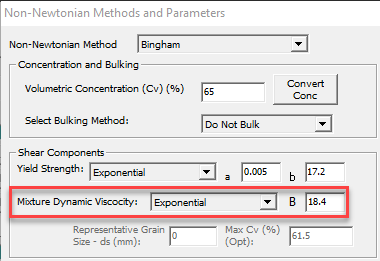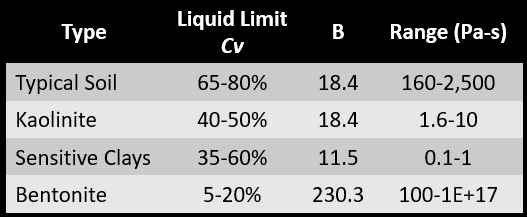Download PDF
Download page Mixture Dynamic Viscosity.
Mixture Dynamic Viscosity
The Mixture Dynamic Viscosity (sometimes called the "Sediment Laden Viscosity") is the viscosity of the mixture. HEC-RAS and DebrisLib use "single phase" models to simulate mud and debris flows. Single phase models do not compute separate fluid and solid mechanics. They assume that the mixture is a homogeneous fluid. Single phase models account for the impacts of the solid fraction by changing the properties of the fluid, including the viscosity.
Two of the rheological models incorporate the impact of the solids, in part, by using a Mixture Dynamic Viscosity, which is the apparent viscosity of the mixture, including the influence of the solid phase on the liquid phase. Mud and debris flows are more viscous than water. The Mixture Dynamic Viscosity includes the impacts of the solid phase on the stress-strain relationship of the mixture. In the Bingham model this mixture viscosity is the slope of the stress-strain relationship and the O'Brien methods adds quadratic terms for other processes, but still uses a Mixture Dynamic Viscosity to compute linear, internal, viscous losses.
Use Realistic Viscocities
Unlike shear strength or some of the non-linear (e.g. HB) rheological parameters, viscosity is a physical property with an intuitive range in the Bingham Model. Consider the viscosity ranges associated with familiar materials (e.g. this chart). While viscosity is a heuristic in the Bingham model, accounting for processes that are not strictly viscous, good conceptual reference points for this parameter are ketchup (~100 Pa-s) and Peanut Butter (250 Pa-s). 1,000 Pa-s is a pretty good conceptual maximum for this parameter.
Also note, viscosity is reported in a wide range of units. The latest version of HEC-RAS includes a conversion calculator to convert these units to Pa-s, which are the units required in HEC-RAS.
HEC-RAS includes four methods to compute the Mixture Dynamic Viscosity. These are described in detail in the Technical Reference Manual. The four methods include:
Exponential
Like Yield Strength, multiple investigations have found that Mixture Dynamic Viscosity has an exponential relationship with volumetric concentration.  The form used by O'Brien (1998) and documented in Julian (1995) has an empirical "multiplier" in the exponent like the Yield Stress Equation but a fixed coefficient in front of the exponential function (0.001). Therefore, the exponential Viscosity equation only has one parameter (compared to the exponential Yield equation that has two):
The form used by O'Brien (1998) and documented in Julian (1995) has an empirical "multiplier" in the exponent like the Yield Stress Equation but a fixed coefficient in front of the exponential function (0.001). Therefore, the exponential Viscosity equation only has one parameter (compared to the exponential Yield equation that has two):
| \mu_r = 0.001e^{BC_v} |
Common values for B are include in the table below. However, because this parameter is in the exponent, the computed viscosity is very sensitive to this value, which has a broad observed range. This is often a calibration parameter.
Coefficients for the viscosity exponential multiplier for different soil types from Julian (1995) (converted to the exponential form).

Modeling Note
Because the exponential equations (for both Yield Strength and Viscosity) include an empirical parameter and the volumetric concentration in the exponent, they can introduce equifinality issues (e.g. compensating errors, increasing one to compensate for setting the other too low) if modelers vary both of them during calibration. When a model has multiple sensitive parameters like this, making the calibration process a non-unique, multi-vitiate solution space, it is often good practice to fix the parameter with the lowest uncertainty and vary the less certain parameter.
User Defined Mixture Dynamic Viscosity
Like the Yield Strength, users can enter the Mixture Dynamic Viscosity directly (in SI viscosity units Pascal-seconds). Also like Yield Strength, there are laboratory methods to measure the mixture viscosity, but these tend to be difficult to transfer to the field (and in situ) measurements of debris flows are rare because the events tend to be unexpected and dangerous. But laboratory experiments often have defined Mixture Dynamic Viscosity and some users may find that calibrating the viscosity directly is more intuitive that calibrating an empirical power multiplier in the exponential approach.
Modeling Note
Because the current version of HEC-RAS has uses a single, users specified, Volumetric Concentration (Cv) for all time and space, both the User Defined and Exponential methods compute constant viscosities throughout the simulation. However, in future versions, which will vary Cv in time (and eventually in space) the Exponential Method will become dynamic, adjusting with Cv, while the User Defined method will remain static.
Maron and Pierce
Maron and Pierce is the default method. This method is popular because it does not require user input or parameters. However, it does compute the Mixture Dynamic Viscosity based on the ratio of the Volumetric Concentration (Cv) to a maximum possible concentration (Max Cv). Max Cv is not a fixed value. It can vary with the gradation (particle size distribution) of the material. HEC-RAS uses the default Max Cv from the Bagnold packing assumption in the O'Brien quadratic (see more discussion of this parameter in the Max Cv section below). However, if you select Maron and Pierce the interface will make this parameter editable whether the O'Brien method is selected or not. Make sure that Max Cv is always greater than Cv. 
Viscosities computed with this equation tend to be substantially lower than those computed with the exponential equation.
User Visc Ratio
It may be more intuitive for modelers to think about the relative viscosity of the mixture, compared to water, instead of the absolute mixture viscosity. The User Visc Ratio computes the Mixture Dynamic Viscosity with a simple, user specified, multiplier of the dynamic viscosity of the water. This approach also incorporates dynamic effects of temperature on the Dynamic Temperature.